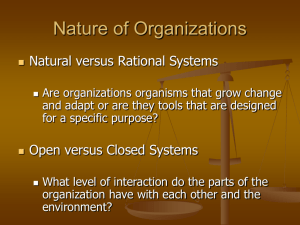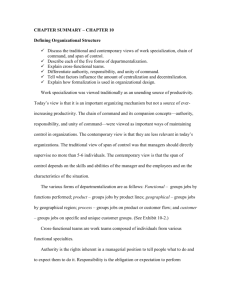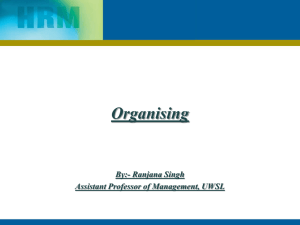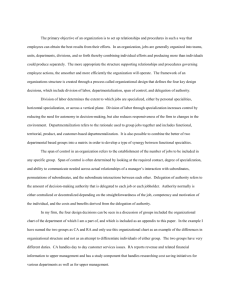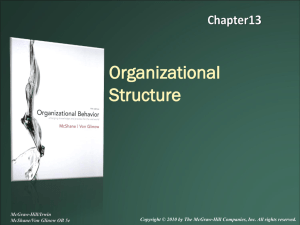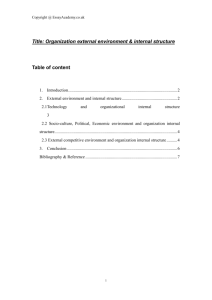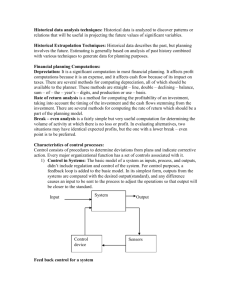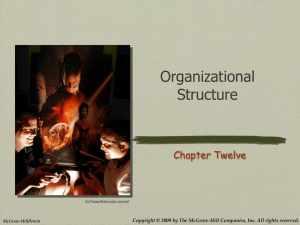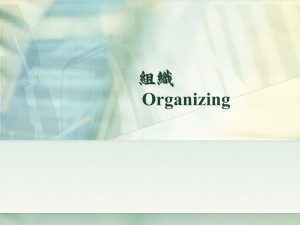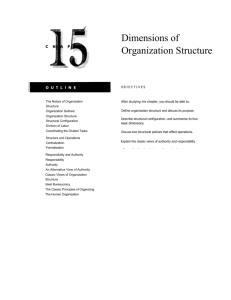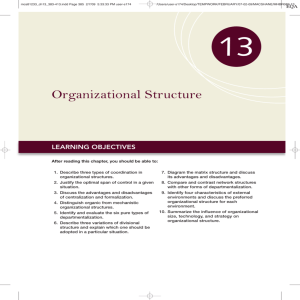Organizational Structure…
advertisement
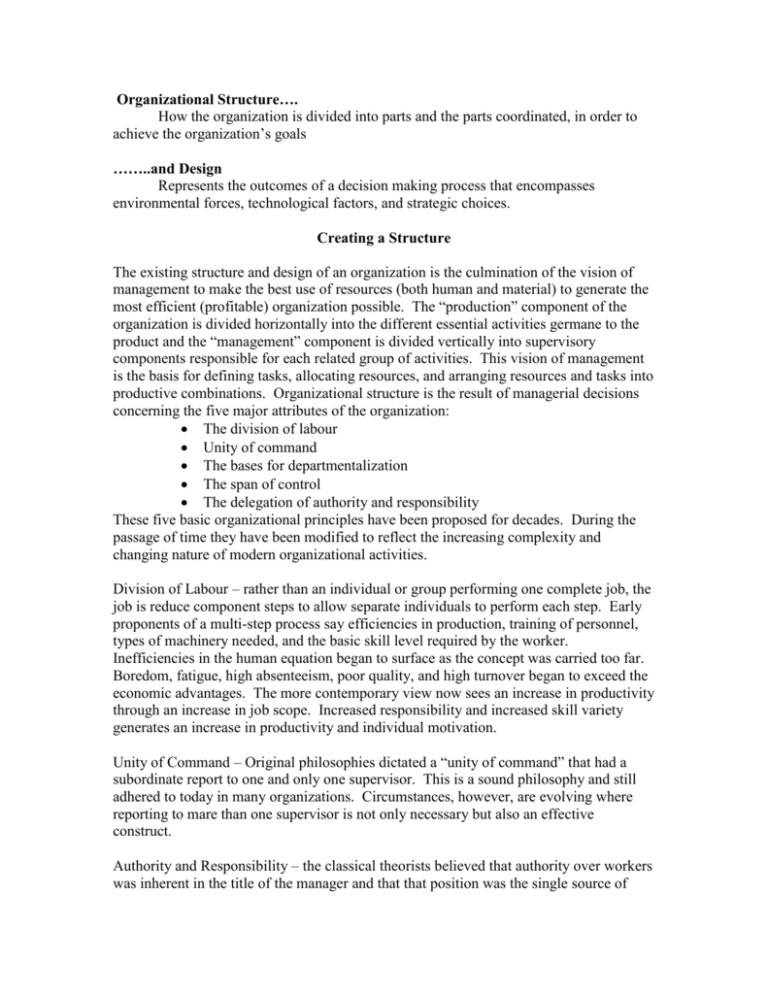
Organizational Structure…. How the organization is divided into parts and the parts coordinated, in order to achieve the organization’s goals ……..and Design Represents the outcomes of a decision making process that encompasses environmental forces, technological factors, and strategic choices. Creating a Structure The existing structure and design of an organization is the culmination of the vision of management to make the best use of resources (both human and material) to generate the most efficient (profitable) organization possible. The “production” component of the organization is divided horizontally into the different essential activities germane to the product and the “management” component is divided vertically into supervisory components responsible for each related group of activities. This vision of management is the basis for defining tasks, allocating resources, and arranging resources and tasks into productive combinations. Organizational structure is the result of managerial decisions concerning the five major attributes of the organization: The division of labour Unity of command The bases for departmentalization The span of control The delegation of authority and responsibility These five basic organizational principles have been proposed for decades. During the passage of time they have been modified to reflect the increasing complexity and changing nature of modern organizational activities. Division of Labour – rather than an individual or group performing one complete job, the job is reduce component steps to allow separate individuals to perform each step. Early proponents of a multi-step process say efficiencies in production, training of personnel, types of machinery needed, and the basic skill level required by the worker. Inefficiencies in the human equation began to surface as the concept was carried too far. Boredom, fatigue, high absenteeism, poor quality, and high turnover began to exceed the economic advantages. The more contemporary view now sees an increase in productivity through an increase in job scope. Increased responsibility and increased skill variety generates an increase in productivity and individual motivation. Unity of Command – Original philosophies dictated a “unity of command” that had a subordinate report to one and only one supervisor. This is a sound philosophy and still adhered to today in many organizations. Circumstances, however, are evolving where reporting to mare than one supervisor is not only necessary but also an effective construct. Authority and Responsibility – the classical theorists believed that authority over workers was inherent in the title of the manager and that that position was the single source of influence in the department. Reality and a valued work force have altered that type of thinking. The organization itself has turned to worker participation, teams, and decentralized decision-making in order to decrease the hierarchical structure, recognize the strengths of the workforce, and raise motivation to an intrinsic level within each member of the organization. Span of control – the same theorists that believed in the inherent authority in a title believed in small ratios of workers to supervisors. This narrow span of control was (in their minds) necessary to maintain control, however, supporting that type of hierarchy was costly. Wider spans of control became efficient in terms of administrative salary but had the effect of lessening the effectiveness of the organization. To compensate for the potential loss, other aspects of the workforce were examined in order to establish an appropriate worker- manager ratio. Contingency variables such as worker training, education, experience, complexity of task, and preferred leadership style of the manager helped to determine an appropriate ratio. Departmentalization – the consideration for departments within an organization have not changed significantly from forty years ago to today. Departmentalization by function, product, geography, or process is still valid depending on the needs of the organization. What is changing is the focus of the organization from a concern for the product to a concern for customer needs. Refocusing has lead to the integration of some existing designs and, in some instances, the establishment of dual leadership models. Organizational Structure Task Requirements Technology Job Design Factors Managerial Decisions 1. Division of Labour 2. Bases for Departmentalization 3. Size of Departments 4. Delegation of Authority Tecnology Environmental Uncertainty Ability/Skill Decisions of Organizational Structure Organizational Effectiveness 1. Formalization 1. Production 2. Complexity 3. Centralization 2. Satisfaction 3. Efficiency Organizational Design Factors 4. Adaptiveness 5. Development 6. Survival Strategy Managerial Choices The structure of an organization is the formal system of working relationships that both divide and coordinate the tasks of multiple people and groups to serve a common purpose. Typically, the structure of an organization is represented in the form of an organizational chart. From the chart, pertinent information can be extrapolated pertaining to the organization’s basic structure and mode of operation. Basic Organizational Information (from and organizational chart) The division of work The type of work performed Supervisor-subordinate relationships Sub-unit groups or components The levels of management Communication channels Mechanistic and Organic Systems Three key components of organizational structures are formalization, centralization, and complexity. Formalization refers to the extent to which job activity is defined and controlled by rules. The more rules there are about how work is done and how decisions are made the more the organization is formalized. The degree to which an organization is formalized directly impacts on the amount of discretion available to employees in the performance of their jobs. Highly formalized organizations have standardized job descriptions resulting in consistent and uniform output. Generally, the narrower the required skill set for a particular job the higher the formalization of that job. Centralization refers to the “location” within the organization where decisions are made and is in reference to formal authority only. Vertical Centralization is high if decisions are made from top management; whereas, vertical centralization is low if employees at the lower end of the hierarchy are given authority to make decisions. Horizontal decentralization occurs when workers in many different organizational units are allowed to make decisions without referring to a more central authority. Complexity is a reference to the amount of vertical, and spatial differentiation within an organization. Horizontal differentiation refers to the extent to which work unit members differ in the nature of the tasks to perform and their level of education and training. The larger the number of different department occupations within an organization the more horizontally complex it is. Vertical departmentalization measures the depth of the structure. Differentiation amd complexity increase as the number of hierarchial levels increases. The taller the structure the more difficult communication and coordination of decisionmaking become. Spatial differentiation measures the geographical distance separating offices, production plants, and personnel within the organization. The greater the separation the more complex the operation of the organization becomes. These two components of formalization and centralization can be expanded into two broad categories of organizational structure: mechanistic – having structure appropriate for an unchanging environment; and organic – having a structure appropriate for a changing environment. The Importance of Organizational Structure The study of organizational structure has been a central topic in organizational theory right from its origins in the work of Max Weber. This is because it is primarily through the design of structure that managers try to ensure that work is performed and acceptable outcomes achieved. The emphases throughout the 1980’s and the 1990’s on such topics as empowerment, transformational leadership, total quality management (TQM), and teams are all part of “restructuring” attempts to change the was organizations are structured. Structure will remain important as a topic because these ideas about organizational process come to fruition through structures. TQM, for example, demands that the division of work between units is examined, that procedures are reviewed, that the distribution of authority is altered, and so on. Similarly, changing the structure of an organization is often the starting point for trying to revitalize the way the company is managed. Managers will decide to divisionalize, to redraw the relationships between headquarters and local branches, to emphasize marketing more, etc. All of these mean that we have to examine the basics of organization structure. Structure, then, is central, and interconnected with all aspects of the organizational functioning. We are living in an era of constant restructuring and there foes not seem to be and end in sight. Through restructuring managers try to change the behaviors and attitudes of people in organizations. And when a manager starts organizational change by trying to deal with motivations and leadership, there are always consequences for structure. So, structure has been, is, and will continue to be important in understanding organizations. Guidelines to Organizational Design Two key factors in organizational design are “environmental forces” and “technological forces”. These factors, in combination, frame the most likely design for a successful organization. Each factor, in degree on complexity, ranges from stable (simple) to dynamic (complex). One end of the continuum represents stability in customer base, and uniformity in technology and markets while the other end reflects customer diversity, and changing technologies and markets. As the complexity of the organization’s environment changes some version of the designs noted in the model will best meet the needs of the organization. Recent trends in organizational design suggest that organizations are moving, from a bureaucratic (mechanistic) design to a flexible (organic) design. The trend reflects, a change in decision-making (from centralized top-down direction to decentralized localized autonomy), a widening span of control (a flatter organizational hierarchy), and a redesign of job responsibilities (less routine, more variety and responsibility). While the trend in organizational design is a flatter hierarchy, there are many issues to consider. The arrangement of hierarchial authority (chain of command) will ultimately determine the shape of the organization. Some organizations are desribed as “tall”, other’s “flat”. In “tall” organizations there are many layers but few people reporting to an individual supervisor. In “flatter” organizations there are fewer layers and more people reporting to an individual supervisor. Mechanistic Organizations Mechanistic organizations are characterized by highly specialized tasks that tend to be rigidly defined. The authority and control are hierarchical and communication is generally from the top down. Obedience to superiors would, at least on the surface, be a facit of the culture. Mechanistic organizations are very highly formalized and centralized. Members tend to view their responsibilities in terms of their immediate role descriptions, are less adaptive to change, and rarely will be creative in the task to be done. Characteristics Attributes Reliance on formal rules and regulations Rules and regulations designed to control behaviour Fit the mould mentality Centralization of decision-making Extensive impersonal rules around employee decision-making Decisions made from within higher departments for lower departments Narrowly defined job responsibilities Jobs are in specified areas of expertise with strictly defined parameters Routine/simplistic tasks (promotes boredom) Rigid hierarchy of authority The “position” about tightly controls the “position” below Many levels of authority Smaller group of workers to control (narrower span of control) Promotion follows a ladder and climbing it depends on seniority and the judgement of superiors Organic Organizations Organic Organizations are characterized by a flexible approach to tasks where roles are interdependent and continually adjusted and redefined through interaction with organizational members. Control depends less on formal job description and more on expertise relevant to the task to be performed. Communication is both vertical and horizontal depending on the needed information. Members will accept responsibility for task accomplishment beyond their role description, are more likely to adapt to change, and be creative in their approach to task accomplishment. Characteristics Low to moderate use of formal rules and regulations Attributes Rules and regulations designed to encourage behaviour beyond the norm Encourages innovation Decentralized and shared decisionmaking Coordination and communication are easier Decisions are made within and across levels Broadly defined job responsibilities Task scope and task variety are enhanced Multiple skills are an expectation Flexible authority structure More autonomy to make decisions within Departments “Decision approval” is not a prerequisite Fewer levels of authority Wider span of control (fewer managers for more workers) Promotion reflects “best person for the job” mentality Organizational design structures very according to the needs of the organization as perceived by the management of the organization. Each design structure has advantages and disadvantages and no one design more suitable than another. Design by Function Organizations designed by function focus their structure around the key functions (tasks and activities) to be performed. Each department is responsible for performing a unique activity, such as marketing, promotion or distribution. Divisional managers would be responsible for the supervision of departments reporting to them. Advantages Work best if company has single product line Disadvantages Specialization promotes tunnel vision Encourages specialization “Turf” protection becomes an issue Employees strive to maintain latest technical knowledge related to field of expertise Decisions are slowed as bureaucracy becomes more layered High functional efficiency Resistance to change often occurs Reduces duplication of activities Resistance to change often occurs Encourages technical expertise Maintaining overall quality is difficult Allows task assignments consistent with technical training Many employees do not see the “big picture” Promotes high quality technical problemsolving Creating broad based managerial sills is difficult Department goals favoured over organizations’ goals Design by Geography Organizations that are designed based on geographical considerations tend to do so as a consequence of size or manufacturing needs. Cultures within the organization will differ because of the difference in the cultural backgrounds of the workers. Management actions will reflect diversity of the organization’s host country or cluster of countries. Advantages Emphasizes local adaptation to market and/or supplier conditions Especially suited to local businesses Regional structures allow local personnel to apply and respond to local customer service needs Local managers become responsible for both revenue and expenses Provides a training ground for managerial personnel Disadvantages Difficult to maintain consistency of image and customer service Head office managers struggle with amount of autonomy to give local managers Size of each operation can dictate the amount of autonomy allowed each manager Design by Product Line Organizations that have several product lines have organizations generally designed with the product as the focus. This type of design generates self-contained units each capable of developing, producing, and marketing its own goods and service. Design by product encourages pooled interdependence among different divisions but often uses specialpurpose technology or equipment. Advantages Reduces complexity that managers face Promotes initiative and autonomy Promotes entrepreneurial behaviour Promotes decentralization of decision making Beneficial design when environmental and technological factors are different for each product line Focuses on results Disadvantages Difficult to coordinate related business activities Rivalry inside and outside the organization can exist Economy of scale could be lost if information not shared Certain degree of redundancy Increased organizational costs with potential reduction in efficiency Design by Customer/Market Venue Organizations designed by customer needs or market segments usually combine one or more of the designs within its structure. Customer needs based organization can adapt readily to market feedback concerning their products and the customers preferences towards those products. Advantages A beneficial design when the product is marketed to a distinct population Quality service is a focus throughout the organization Quick response to market feedback Disadvantages Many aspects of the organization are in constant flux Personnel must be comfortable in an ever changing environment Design by Matrix Organizations that utilize a matrix design integrate functional and product designs through the use of dual authority, information, and reporting systems. The matrix system contains three distinct levels, the CEO, two managers for the functional and product departments (each reporting to the CEO, each other, and sharing staff), and the managers of specialized functions who report to both department managers. A matrix designed organization strives to achieve a balance by overlaying a horizontal structure of authority, influence, and communication on the vertical structure. Personnel belong to the product and function department. Advantages Employees are highly responsive to both function and product line Flexibility of employee assignment Works well for organizations with many product lines but limited resources Employees must integrate work with each of the department Makes best use of specialists who would not normally be full-time in one area Specialized resources Disadvantages Constant tension between functional specialty and product line Dual authority structure difficult to maintain Employees have a difficulty adjusting to the dual command Demands substantial management support Increases potential for power conflicts Special training may be needed to implement the design Multinational Organizations that use a multinational design maintain coordination across product, function, and geographic areas. Because the logistics of such a design are complex, most organizations using this design focue on the needs of product and place design. The most prevalent departmental basis is “territory”. Generally, national and regional managers will report to “headquarters” in the same national or regional area. Each national or regional area has the same resources necessary to produce and market the product or service. Advantages Suitable for limited product lines If the organization is product based then world-wide responsibility can be assigned to one corporate office Disadvantages Coordination is difficult Departmentalization is the key in the organization’s design If an organization is function based then corporate offices for each function can be established with responsibility world-wide Decisions on a manager’s span of control is another key issues The Network Structure Network Structure is one of the newest developments in organizational structure which has been made possible by the advances in connecting interorganizational computers. The structure is a small centralized organization that relies on other organizations to perform marketing, manufacturing, distribution, and other business functions n a contract basis. The network structure is an organization of relationships. Unlike traditional organizational structures that maintain research and development, production, sales and marketing all in-house, the network structure will contract with outside organizations for the functions that they required. The necessary operations are coordinated through interfacing computer networks. The contractual nature of the organization allows the management to concentrate on what the organization does best, typically design and marketing. While not a structure suitable to all organizations, it fits industrial firms which, require low cost labour, and must be able to adjust rapidly to evolving market conditions. Span of Control “the number of individuals who report to a specific manager” As noted previously the trend in organizational structure is to a leaner, flatter structure. Widening the “span of control” (increasing the ration of the number of employees reporting to one supervisor) not only has an effect on the structural shape of the organization but also a profound effect on the type of organization that evolves (organic or mechanistic). The key question that must be answered when considering a change in supervision is “Will the organization be more effective if the span of control is narrow or wide?” Tall organizations (many levels) are suites to a type of work that is routine in nature (repetitive and narrow in scope), time (connected in production flow), and whose workforce required a minimal variety of skill. The nature of the work does not permit or need creativity/insight into effectiveness. In many instances the workforce itself may need close supervision, especially if the members are not highly educated. Formalization of rules and vertical centralization of power will frame the existence of a tall organization. Flatter organizations (fewer levels) are suited to work that requires planning, thought and decision-making on a continuing basis. Less formalization of rules and horizontal decentralization of decision-making are distinctive traits of a flatter organization. Individuals and teams are expected to pursue continuous improvement. Task roles and responsibilities will change as members encompass and adopt on-going necessary changes. Individuals are expected to be highly involved in the organization and its future. What shape best suits the Organization? The fundamental reason for the establishment of an organizational structure is to accomplish work that cannot be accomplished by one individual on their own. No one organizational structure can be perfect for all situations. The prime target of the organization is to create a structure that merges task specialization with task integration under an appropriate chain of command. An appropriate chain of command is a reflection of the competency of the members of the organization. The greater the ability of the individual to perform a task and the more willing the individual to accept responsibility, the higher the chances are of success for a “widened span of control”. Inherent in tall organizations is the underutilization of the worker’s potential as well as a low level of motivation. Control by the supervisor is high, a product of constant interaction and a small workforce. Widening the span of control promotes autonomy, higher involvement in task, and in increase in motivation. It also lessons the amount of control supervisors have over workers. Interaction is decreased, increasing the necessity for localized departmental day-to-day decision-making. Narrow spans of control are indicative of bureaucratic organizations depicted in pyramidal from. Highly specialized functions, clearly defined departmental boundaries, “routine” job descriptions, and close supervisory control make sure that work is completed. The characteristics of this type of structure are outlined on page 4. They are designed to control the employee’s behaviour and decrease empowerment creating an organizational culture that is generally passive/aggressive in nature with an aggressive/defensive leadership style. The narrower the pyramid, the smaller the span of control ratio. The smaller the ration the greater the expense that the organization has in administrative costs to maintain that ration. If the ration is 1:5 then a four layer pyramidal system could employ 125 workers. If the ration were increased to 1:8 then in the same four layer structure 512 workers could be employed. The increase in personnel supervised is exponential and can represent a significant cost reduction to the organization by raising the ratio even slightly. As the organization flattens the human limitations of leadership will spawn attributes of an organic structure. Individuals and teams, lacking supervision will begin to make decisions on their own. Assuming the workers are positively motivated, the decisions will be made with the betterment of production in mind.
